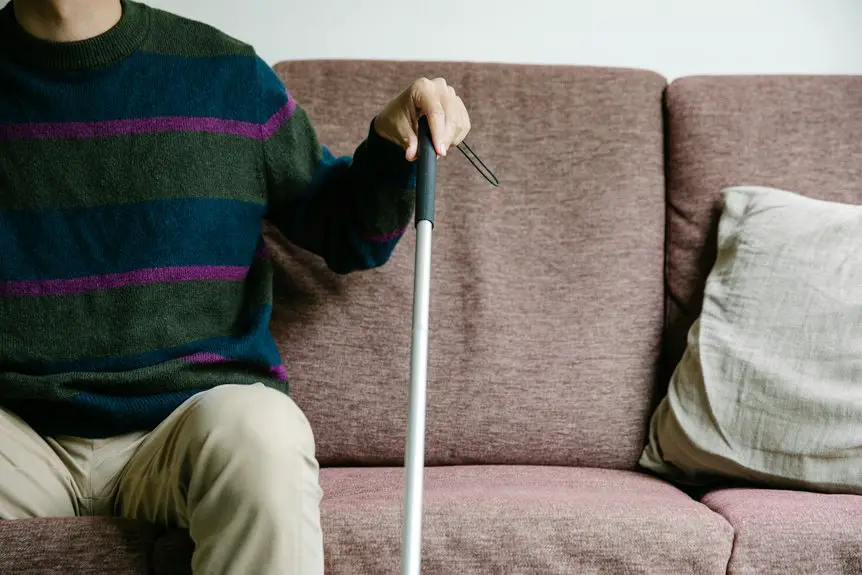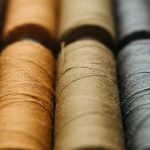Polypropylene fabric feels lightweight and smooth, giving you a barely-there sensation that’s great for staying cool and comfortable. It’s moisture-resistant and wicks sweat away quickly, so you stay dry during activity. The texture is firmer than cotton but softer than some synthetics, with enough breathability to regulate temperature well. It’s durable and holds up after washing without losing its feel. If you want to understand how it compares to other fabrics and care tips, there’s more to explore.
Table of Contents
Key Takeaways
- Polypropylene feels smooth and slightly firm, softer than nylon but less plush than cotton or wool.
- It is lightweight and airy, creating a barely-there sensation on the skin.
- The fabric is moisture-wicking and breathable, keeping skin dry and cool during activity.
- Polypropylene maintains a consistent texture over time without pilling or losing shape.
- Woven polypropylene feels rougher and more structured, while non-woven is softer and more flexible.
Overview of Polypropylene Fabric Composition
Polypropylene fabric is made from a thermoplastic polymer derived from propylene gas. When you wear or handle it, you’re interacting with fibers created through a process called polymerization, which links propylene molecules into long chains.
This material’s structure makes it lightweight yet strong, resistant to moisture, and quick-drying. You’ll find polypropylene fabric in activewear, outdoor gear, and upholstery because it doesn’t absorb water easily, helping you stay dry.
The fibers have a relatively low density, so the fabric feels light without bulk. Its chemical composition also makes it resistant to stains and chemicals, meaning it maintains its integrity even with frequent use.
When you understand this, you can better appreciate why polypropylene fabric performs well in demanding conditions.
Softness and Smoothness Compared to Other Fabrics
You’ll notice polypropylene fabric feels different when you compare its softness to natural fibers like cotton or wool.
It tends to be smoother but might lack the plush comfort you’re used to with natural materials.
Understanding this texture difference can help you decide how it fits into your everyday wardrobe.
Comparing Softness Levels
When you touch polypropylene fabric, you might notice it feels different from natural fibers like cotton or wool. It’s generally less soft, with a slightly coarse texture that some find less cozy against the skin.
While cotton offers a plush, breathable softness and wool provides warmth with a gentle fuzziness, polypropylene feels more utilitarian. Its softness level falls somewhere between synthetic fabrics like nylon and polyester—it’s smooth but lacks the cushioning softness of natural fibers.
If you’re used to the gentle feel of cotton T-shirts or wool sweaters, polypropylene’s firmness might stand out. However, its durability and moisture-wicking properties often outweigh this slight difference in softness for activewear or outdoor gear.
Smoothness Versus Natural Fibers
Smoothness plays a key role in how a fabric feels against your skin, and it often shapes your comfort level.
Polypropylene fabric tends to feel smoother than many natural fibers like cotton or wool because its synthetic fibers create a more uniform surface. When you touch polypropylene, you’ll notice it glides more easily over your skin without the slight roughness natural fibers sometimes have.
However, this smoothness can feel less breathable compared to the cozy, breathable texture natural fibers provide. While polypropylene won’t have the same warm softness of wool or cotton, its sleek finish makes it ideal if you prefer a fabric that feels slick and less fuzzy.
Understanding these differences helps you pick the right fabric for your comfort needs.
Texture in Everyday Use
Compared to natural fabrics, polypropylene offers a distinct feel that affects how it performs in daily wear.
When you wear polypropylene, you’ll notice it feels lighter and smoother against your skin than wool or cotton. It doesn’t have the same softness you get from natural fibers like cashmere, but it’s less prone to irritation and stays comfortable even during intense activity.
You’ll appreciate its moisture-wicking properties, which keep you dry without feeling sticky. Polypropylene’s texture is more uniform and synthetic, so it lacks the cozy warmth of natural fabrics but excels in durability and quick drying.
When choosing everyday clothing, you’ll find polypropylene ideal for activewear or layering pieces where smoothness and breathability matter most.
Breathability and Moisture-Wicking Properties
You’ll notice polypropylene fabric allows good airflow, keeping you cool during activity.
It efficiently wicks moisture away from your skin, so sweat doesn’t linger.
This combination makes it great for staying dry and comfortable.
Airflow and Ventilation
Although polypropylene fabric feels lightweight, it excels at promoting airflow and ventilation, which keeps you comfortable during physical activities.
The fabric’s unique fiber structure allows air to circulate freely, preventing heat buildup next to your skin. When you move or sweat, this airflow helps regulate your body temperature by allowing moisture vapor to escape quickly.
You won’t feel clammy or overheated because the fabric doesn’t trap heat or moisture. Instead, it encourages a continuous exchange of air, which refreshes your skin and reduces irritation.
Whether you’re hiking, running, or just going about your day, polypropylene’s ventilation properties guarantee you stay cool and dry. This breathability makes it an excellent choice for activewear and outdoor gear designed to keep you comfortable.
Sweat Absorption Efficiency
When you sweat, polypropylene fabric actively pulls moisture away from your skin, keeping you dry and comfortable. Its unique fibers don’t absorb water; instead, they transport sweat to the fabric’s surface, where it evaporates quickly.
This moisture-wicking ability helps regulate your body temperature and prevents that sticky, clammy feeling you get with other materials. You’ll notice polypropylene feels lightweight and smooth, even when working hard or in humid conditions.
Plus, its breathability allows air to circulate freely, enhancing the drying process. Whether you’re exercising, hiking, or just going about your day, polypropylene fabric helps you stay fresh by managing sweat efficiently without weighing you down or losing shape.
It’s a smart choice for activewear and everyday comfort.
Lightweight Nature and Its Impact on Feel
Polypropylene fabric weighs considerably less than many other textiles, which directly influences how it feels against your skin.
Because it’s so light, you’ll hardly notice you’re wearing it, making it perfect for activewear and layering. This lightweight nature allows air to circulate easily, keeping you feeling cool and unrestricted throughout the day.
When you put on polypropylene, it feels airy and barely there, reducing any sense of bulkiness or heaviness. This can be especially beneficial during physical activities or in warm weather, as it won’t weigh you down or trap heat.
You’ll appreciate how this fabric moves with you effortlessly, providing comfort without sacrificing performance. Its lightness enhances your overall wearing experience, making polypropylene a smart choice for those seeking breathable, unobtrusive clothing.
Durability and Texture Over Time
Because you’ll likely wear polypropylene fabric frequently, its durability becomes a key factor in how it feels over time.
You’ll notice that polypropylene resists wear and tear exceptionally well, maintaining its texture even after numerous washes. Unlike natural fibers, it doesn’t easily pill or lose shape, so the fabric stays smooth and consistent.
Over time, you won’t experience much roughening or stiffening, which keeps it comfortable against your skin. However, prolonged exposure to high heat can degrade the fibers, potentially making the fabric feel less soft.
Polypropylene remains soft over time but can feel less comfortable if exposed to high heat repeatedly.
To keep that fresh, lightweight feel, you should follow care instructions meticulously.
Common Uses Influenced by Texture
Since the fabric feels lightweight and smooth against your skin, you’ll often find polypropylene used in activewear and performance clothing.
Its texture lets you move comfortably without irritation, making it ideal for activities requiring flexibility and moisture management. You’ll also notice polypropylene in outdoor gear, where its quick-drying nature keeps you comfortable.
Additionally, this fabric’s texture suits medical textiles, providing softness against sensitive skin. Even in household items, polypropylene’s tactile qualities are a key factor.
Common uses influenced by polypropylene’s texture include:
- Athletic wear that stays dry and light during exercise
- Outdoor jackets and gear that resist moisture
- Medical bandages and wraps that avoid irritation
- Home textiles like upholstery and rugs that feel soft yet durable
Its texture directly shapes how and where you’ll experience this fabric.
How Polypropylene Fabric Handles Temperature
When you wear polypropylene fabric, you’ll notice it helps regulate your body temperature by trapping heat without causing overheating. This fabric’s unique structure allows it to insulate efficiently while letting moisture escape, keeping you dry and comfortable in various conditions. Whether you’re active or resting, polypropylene adapts well to temperature changes.
| Temperature Condition | Polypropylene Response |
|---|---|
| Cold Weather | Retains body heat, keeps you warm |
| Warm Weather | Wicks moisture, prevents overheating |
| Variable Activity | Balances heat retention and breathability |
Differences Between Woven and Non-Woven Polypropylene
Understanding how polypropylene manages temperature is just one part of appreciating its versatility.
When it comes to texture, woven and non-woven polypropylene feel quite different. Woven polypropylene has a structured, slightly rough texture because it’s made by interlacing strands tightly. Non-woven polypropylene, on the other hand, feels softer and more fabric-like since it’s bonded together without weaving.
Here’s what sets them apart:
- Woven polypropylene feels firmer and more durable.
- Non-woven polypropylene feels lightweight and flexible.
- Woven types often have a grid-like pattern you can see and feel.
- Non-woven types feel smoother but less sturdy.
Knowing these differences helps you choose the right polypropylene fabric for your needs.
Care Instructions That Affect Fabric Feel
Although polypropylene fabric is known for its durability, how you care for it directly impacts its feel and longevity. You should always wash polypropylene in cold water to prevent heat damage, which can make the fabric stiff or brittle.
Avoid using fabric softeners, as they can leave residue that alters the fabric’s smooth texture. Instead, opt for a mild detergent and a gentle cycle to maintain softness.
When drying, skip high heat; air drying or using a low-heat setting preserves the fabric’s flexibility and prevents shrinkage. Also, avoid ironing polypropylene since high temperatures can melt the fibers and ruin the texture.
Comparing Polypropylene to Other Synthetic Fabrics
Since you’re choosing fabrics for your needs, comparing polypropylene to other synthetic materials helps highlight its unique qualities.
Polypropylene stands out for its lightweight, moisture-wicking properties, and resistance to odors, making it ideal for activewear. Unlike polyester, which can feel heavier and less breathable, polypropylene keeps you dry and comfortable.
Polypropylene’s lightweight, moisture-wicking, and odor-resistant qualities make it perfect for staying dry and comfortable during activity.
Nylon offers durability but tends to retain more heat, while acrylic mimics wool’s softness but lacks polypropylene’s quick-drying ability.
Consider these differences:
- Polypropylene feels smooth and dry against your skin, reducing irritation.
- It excels in moisture management compared to polyester and nylon.
- Nylon is stronger but can trap heat more than polypropylene.
- Acrylic offers warmth but doesn’t wick moisture as effectively.
These points help you pick the fabric that best matches your comfort and performance needs.
Frequently Asked Questions
Is Polypropylene Fabric Hypoallergenic for Sensitive Skin?
You’ll find polypropylene fabric is generally hypoallergenic, so it’s great for sensitive skin. It resists allergens and irritants, reducing reactions. However, always test a small area first, since individual sensitivities can vary.
Can Polypropylene Fabric Be Recycled or Is It Eco-Friendly?
You can recycle polypropylene fabric since it’s a type of plastic, but its eco-friendliness depends on how it’s processed. It’s more sustainable than some fabrics, yet proper recycling and disposal are essential to reduce environmental impact.
Does Polypropylene Fabric Retain Odors After Sweating?
Imagine stepping out after a workout—polypropylene fabric won’t trap that sweaty smell like cotton does. You’ll find it resists odors well, keeping your gear fresher, so you won’t worry about lingering stinky smells.
How Does Polypropylene Fabric React to Sunlight Exposure?
You’ll find polypropylene resists sunlight pretty well, but prolonged exposure can cause some fading and weakening. It’s durable overall, but you shouldn’t leave it in direct sun for too long to keep it in good shape.
Is Polypropylene Fabric Safe for Children’S Clothing?
Yes, polypropylene fabric is safe for children’s clothing. You’ll find it’s lightweight, breathable, and resistant to moisture, making it comfortable and durable for kids. Just verify it’s free from harmful additives or chemicals for extra safety.
- What Is Spunmelt Nonwoven Fabric? - July 9, 2025
- A Guide to Nonwoven Polypropylene Bags - July 9, 2025
- What Is Nonwoven Interfacing Made Of? - July 9, 2025







